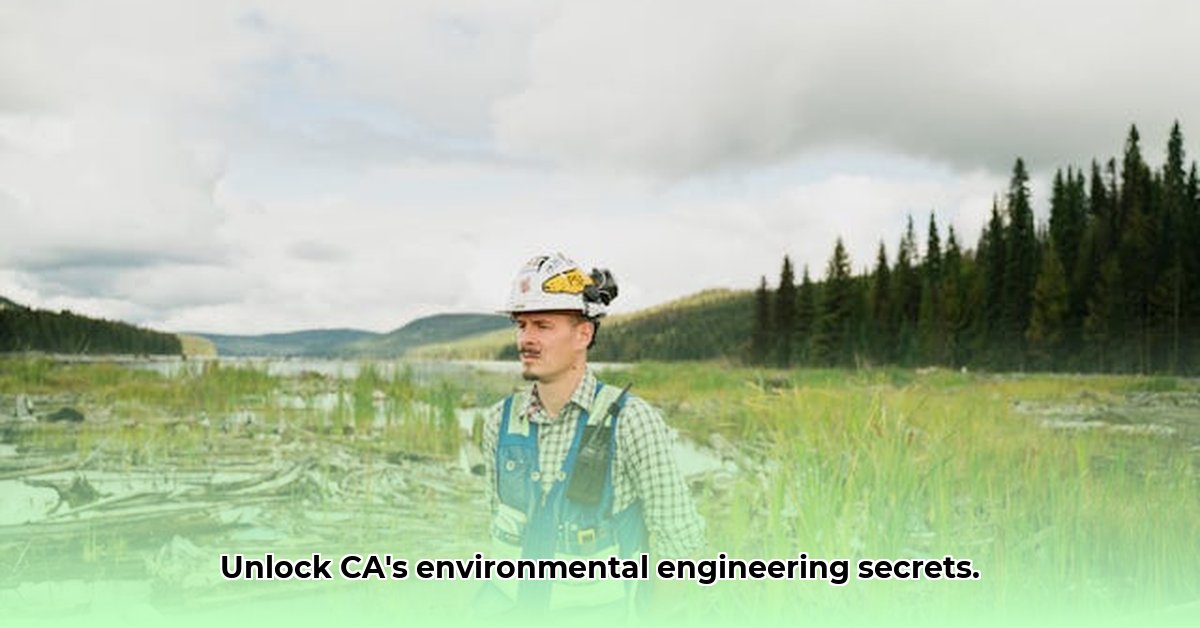California’s environmental consulting industry presents both lucrative opportunities and significant challenges. This report dissects current trends, offering actionable insights for navigating this dynamic market. We’ll explore key challenges, top firms, regulatory impacts, and strategies for success. Consider it a practical guide to thriving in California’s environmental consulting sector, offering a roadmap to building a successful environmental engineering business.
Environmental Engineering Success in California: Consulting Trends – Regulations and Innovation
California’s environmental engineering consulting industry flourishes, fueled by the state’s stringent environmental regulations and a growing emphasis on sustainability. This creates a high demand for expertise in environmental regulations and firms capable of assisting businesses and government entities in complying with complex rules while pioneering sustainable solutions.
Navigating California’s Dynamic Environmental Engineering Market: Compliance and Sustainability
California’s environmental regulations consistently push the boundaries of environmental protection. Companies require expert assistance to understand and meet increasingly stringent requirements, driving the demand for environmental engineering consultants. Beyond basic environmental impact reports, consultants are now tasked with developing innovative strategies to reduce environmental footprints, promote renewable energy adoption, and enhance overall sustainability. Government entities and private sector companies represent substantial client bases, resulting in a multifaceted and expansive environmental sector. However, keen awareness of a crowded marketplace is crucial, requiring innovative approaches to differentiating services.
Key Players and Their Winning Strategies: Long-Term Growth
The most successful environmental engineering firms in California are at the forefront of innovation, assisting businesses in adapting to climate change and pioneering cutting-edge clean energy technologies. Beyond technical expertise, they cultivate strong, lasting relationships with clients, demonstrating a commitment to long-term growth and environmental stewardship. These firms also leverage advanced technologies, such as AI-powered environmental monitoring systems, to gain a competitive advantage. These specialized firms significantly impact California’s sustainable practices by driving adoption of best-in-class technologies and strategies.
However, achieving lasting success requires continuous adaptation and expansion into emerging domains. Forward-thinking firms are venturing into carbon emissions accounting and circular economy solutions (large-scale recycling and waste reduction). Investment in research and development remains critical for maintaining leading-edge innovation. Furthermore, strategic partnerships and mergers facilitate the creation of combined expertise and resources.
The Role of Government and Industry Collaboration: A Two-Way Street – Regulations
Government agencies, such as the California Environmental Protection Agency (CalEPA), play a key role in enforcing environmental regulations while simultaneously striving to ease compliance for businesses. Streamlining the permitting process, maintaining regulatory transparency, and providing comprehensive data and tools can significantly improve efficiency. CalEPA is also actively developing long-term climate adaptation plans. Robust enforcement and public awareness campaigns are crucial for reinforcing the importance of environmental protection. Collaborative efforts, such as joint research projects and public-private partnerships, can accelerate the development and deployment of innovative environmental solutions.
Businesses also need to proactively conduct robust environmental assessments to understand their impact and implement sustainable practices. Implementing stringent environmental management systems demonstrates a commitment to environmental responsibility. Companies are urged to establish ambitious, measurable sustainability targets and incorporate Environmental, Social, and Governance (ESG) factors into overall business strategies. Integrating ESG considerations transcends mere compliance, demonstrating a genuine commitment to sustainability for investors and consumers.
Actionable Insights for Stakeholders: A Roadmap to Success
A breakdown of key focus areas is essential for stakeholders planning for immediate and long-term success:
| Stakeholder | Short-Term Actions (0-1 Year) | Long-Term Actions (3-5 Years) |
|---|---|---|
| Environmental Consulting Firms | Develop specialized expertise, build strong client networks, adopt advanced technologies. | Expand services into emerging markets, invest in R&D, explore strategic alliances and mergers. |
| Government Agencies | Simplify permitting, improve data accessibility, invest in data-driven decision-making tools. | Develop comprehensive climate adaptation plans, enforce regulations effectively, boost public awareness. |
| Businesses (Private Sector) | Conduct thorough environmental assessments, implement sustainable operations, establish robust EMS. | Set ambitious sustainability goals, integrate ESG into corporate strategies, invest in carbon-reducing technologies. |
The Future of Environmental Engineering in California: A Landscape of Opportunity
The California environmental engineering market presents a compelling blend of challenges and opportunities. The state’s ambitious climate objectives, coupled with its unique regulatory landscape, generate significant demand for highly qualified professionals. Continuous learning and adaptation are essential for effectively navigating complex regulations and the rapidly evolving technological landscape. Firms that embrace innovation, prioritize sustainability, and cultivate strong relationships are most likely to thrive.
How to Choose the Best California Environmental Consulting Firm for CEQA Compliance – Due Diligence
Key Takeaways:
- Engaging a consultant early on ensures successful CEQA compliance.
- Thorough documentation and proactive mitigation planning are vital.
- Understanding Negative Declarations, Mitigated Negative Declarations, and EIRs is key.
- Expert guidance is crucial for navigating the legal aspects of CEQA.
- Carefully consider the firm’s expertise, experience, and track record.
Understanding the CEQA Maze – Regulatory Compliance
California’s Environmental Quality Act (CEQA) presents a complex regulatory challenge for both developers and agencies. Successfully complying with CEQA can be pivotal, determining whether a project gains approval. Therefore, choosing the right California environmental consulting firm for CEQA compliance becomes crucial. Seeking expert help is akin to navigating a complex wilderness with a skilled guide, emphasizing the importance of professional assistance for navigating CEQA compliance effectively.
Finding Your CEQA Sherpa: Key Considerations – The Right Firm
What criteria should be used to determine the ‘best’ firm for a project? It requires a company that fully understands the specific needs and intricacies of CEQA:
- Experience: A long, proven track record of successful CEQA projects is crucial.
- Expertise: Does the firm offer projects that have specialists in their field, covering all necessary areas of CEQA compliance?
- Track Record: Client references and past project successes should be thoroughly vetted. Online reviews and industry reputation can also be informative.
- Communication: It’s important for consultants to have clear and concise communication while explaining complex issues and avoiding jargon. They should also be readily available to answer questions and provide updates.
- Proactive Approach: Seek a firm that proactively identifies potential issues and delivers a higher quality of service, anticipating challenges before they arise.
- Cost Structure: Understand the firm’s billing practices and ensure they align with your budget.
Navigating the CEQA Document Landscape – Assessments
There are three primary document types under CEQA: Negative Declarations, Mitigated Negative Declarations, and Environmental Impact Reports (EIRs). Choosing a firm that understands these nuances is key for efficient project completion, as selecting the wrong strategy can cause costly revisions and delays.
The Evolving Landscape of CEQA Compliance – Up to Date
CEQA is continually evolving with changes in legislation and court rulings. Maintaining up-to-date information is key for complying with CEQA. Your firm should be committed to continuously developing their professional knowledge to avoid any problems. Look for firms that actively participate in industry associations and legal updates.
Mitigating Risks: A Proactive Approach – Planning
Solid risk assessment is important to any project. Working with you to identify potential risks is a good way to minimize unforeseen challenges during the CEQA review process.
| Risk Category | Mitigation Strategy |
|---|---|
| Inaccurate Assessment | Thorough data collection, expert review, peer review |
| Insufficient Input from Stakeholders | Proactive outreach, transparent communication, responsiveness |
| Ineffective Mitigation Measures | Rigorous monitoring, adaptive management, contingency planning |
| Legal Challenges | Comprehensive documentation, experienced legal counsel |
California Environmental Consulting Firms: Navigating CEQA and NEPA Compliance – Strategies and Expertise
Key Takeaways:
- Initial studies play a crucial role in figuring out the appropriate level of review.
- Expertise in preparing environmental documents along with managing public review are essential.
- Experience is vital when negotiating with agencies because they may have certain regulatory complexities.
- For guaranteed success, proactive management and strategic planning must be in place.
- Understanding California regulations is non-negotiable.
- Engaging stakeholders is crucial for navigating potential controversies.
- Environmental reviews are essential for incorporating climate change considerations.
Understanding the Landscape of California Environmental Consulting Firms: Navigating CEQA and NEPA Compliance – Regulatory Analysis
The California Environmental Quality Act (CEQA) and the National Environmental Policy Act (NEPA) are the keystones of environmental protection, and navigating them requires specialized expertise. This is where California Environmental Consulting Firms become invaluable. These firms offer assistance, such as: initial environmental studies, preparing documents, and agency interactions. But, how does one choose the right firm for a project?
Choosing the Right Partner: Key Considerations – Your Needs
Selecting a firm is a strategic decision, and they must understand your project’s needs. Knowing what is most important is crucial. Different firms offer different approaches and prioritize their multidisciplinary teams. Consider the firm’s size, location, and specific areas of specialization.
Navigating the Process: From Initial Study to Final Approval – Project
The environmental review process follows a general pattern. This involves an initial study used to determine the level of environmental review needed and document preparation requires a keen eye, while also obtaining agency interaction. This helps ensure a smooth process. A strong project manager within the consulting firm is essential for keeping the process on track and within budget.
Minimizing Risk: A Proactive Approach – Strategic
Potential risks include
- Unveiling Superorganisms: Are Ant Colonies One Mind? - August 2, 2025
- Unveiling The Northern Lights (Aurora Borealis): The Science Behind Nature’s Light Show: 2025 Guide - August 2, 2025
- Unlock Nature’s Sounds: Brain Benefits & Well-being Guide - August 2, 2025















